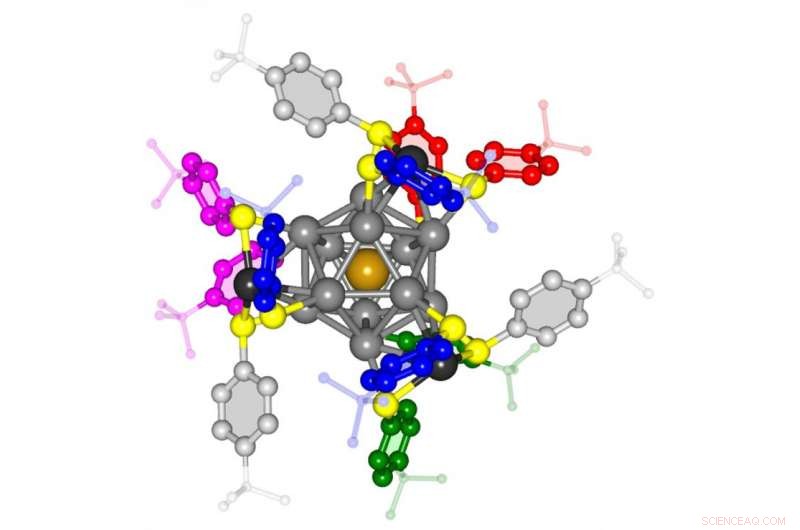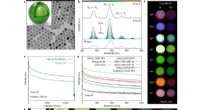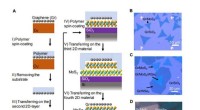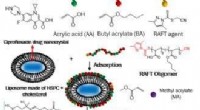
Wetenschap
Hybride benadering voorspelt en bevestigt de structuur van complexe metalen nanodeeltjes

Structuur evolutie spiraal van de AuAg 16 (SR) 12 TROS. De opbouw van de structuur van de organische monolaag-afgedekte metalen AuAg 16 cluster wordt getoond vanaf het centrale enkele goudatoom in het midden en de inkapseling ervan door 12 zilveratomen (grijs) in een AuAg 12 icosaëder. Aftopping van de AuAg 12 kern door verankering van organische benzeenbevattende moleculen via zwavelbevattende mounts (AuAg 16 S 12 ) culmineert in de vorming van de monolaag-afgedekte cluster AuAg 16 (SR) 12 , waarbij de aromatische ringen van de afdekkende monolaag unieke gebundelde dimeer- en trimeerstructuren vertonen. Krediet:Georgia Tech / UT
Een gecombineerde theoretische en experimentele benadering heeft onderzoekers in staat gesteld om de volledige structuur van een monolaag-gecoat moleculair metalen nanodeeltje te voorspellen en te verifiëren. De methodologie werd getest op zilverthiolaat nanodeeltjes, voortbouwend op eerdere kennis over gouden nanodeeltjes, en zal naar verwachting van toepassing zijn op een breed scala aan grootten van nanodeeltjes gemaakt van verschillende elementen.
In een vrijdag gepubliceerde krant 25 november 2016, in het journaal wetenschappelijke vooruitgang , onderzoekers van het Georgia Institute of Technology en de University of Toledo rapporteren over een door röntgenstraling bepaalde structuur die de a priori voorspelling bevestigt, en in combinatie met de theoretische analyse van de eerste beginselen, ondersteunt de onderliggende prognosemethodiek.
"Metalen nanodeeltjes afgedekt door organische liganden hebben een fundamentele en toegepaste betekenis voor het begrijpen van de fysische en chemische principes die de assemblage en atomaire organisatie in nanokristallijne materialen beheersen, en hun potentiële gebruik in velden als kwantumstippen, sensoren, nanokatalysatoren, biomedische beeldvorming, nanokristallijne superroosters en plasmonics, " zei Uzi Landman, Regent's Professor en FE Callaway Chair in de Georgia Tech School of Physics. "We zijn bezig geweest met onderzoek naar de principes die ten grondslag liggen aan de structuren van atomaire en moleculaire nanoclusters, met enkele van onze eerdere voorspellingen die meer dan twee decennia geleden zijn gedaan, en daarom, In zekere zin, de prestatie die in dit document wordt aangetoond, sluit een cirkel voor ons, de weg wijzen naar toekomstige wetenschap die atomair nauwkeurige structuren op deze schaal bestuurt."
Het onderzoek werd ondersteund door de National Science Foundation, het Air Force Office of Scientific Research, en het Amerikaanse Department of Energy's Office of Basic Energy Sciences. Computationeel onderzoek werd uitgevoerd in het Georgia Tech Center for Computational Materials Science.
Sinds de jaren 1990, onderzoekers hebben de unieke eigenschappen onderzocht van metalen nanodeeltjes waarvan de oppervlakken zijn gepassiveerd met behulp van, hoofdzakelijk, organische materialen op zwavelbasis. Deze met thiol bedekte structuren, samengesteld uit tientallen tot honderden atomen, hebben unieke optische en elektrische eigenschappen, afhankelijk van de chemische identiteit van de metalen, het aantal metaalatomen in de kern van nanodeeltjes, en het type en aantal afdekkende organische liganden - die allemaal de structuur van het nanodeeltje bepalen.
Het voorspellen van de structuur van dergelijke nanodeeltjes is een formidabel theoretisch doel, en een experimentele uitdaging. Nanodeeltjes gemaakt van verschillende metalen – goud, zilver, platina, koper, en hun legeringen - kunnen worden gevormd met afmetingen variërend van tientallen tot honderden atomen, wordt gekenmerkt door metaalspecifieke discrete sequenties van aantallen atomen die preferentiële stabiliteiten en hogere abundanties van nanodeeltjes van specifieke afmetingen weerspiegelen. De atomaire bestanddelen in dergelijke stabiele nanodeeltjes zijn georganiseerd in structuren die verschillen van de overeenkomstige bulk atomaire rangschikkingen van de samenstellende metalen. De overvloed aan verschillende structuren die zo zijn gevormd, verklaart de variabiliteit en diversiteit in de fysische en chemische eigenschappen van dergelijke nanomaterialen van eindige grootte. Bovendien, de metalen nanodeeltjes worden afgedekt door zwavelhoudende liganden, waarvan de binding aan de metalen bestanddelen de structurele voorspellingen verder compliceert, merkte Landman op.
"Er is vaak iets dat ten grondslag ligt aan de overvloed en atomaire organisatie in dergelijke deeltjes dat subtiel en ongebruikelijk is, " zei Landman. "De interacties variëren op basis van concurrerende effecten. We hebben geleerd hoe ingewikkeld de effecten van de ligandbinding kunnen zijn, en hoe deze kennis te integreren in een strategie voor het voorspellen van structuren."

The de novo-predicted and X-ray-confirmed structure of the organic thiol-capped AuAg 16 (SR) 12 cluster. The cluster is comprised of a central icosahedral (AuAg 12 , made of a gold atom surrounded by twelve silver atoms), capped by four AgS 3 mounts, each made of a triangle of sulfur atoms, in yellow, bonded to an anchoring silver atom (black). Each of the twelve sulfur atoms is bonded to an aromatic phenyl ring which is crowned by a tetrabutyl group C(CH 3 ) 3 . Most of the aromatic rings are organized in dimer bundles (ring dimers pink, red and green) and a cyclic trimer (blue rings), with the rest three rings remaining unbundled (light gray). Krediet:Georgia Institute of Technology
Using concepts from nucleation theory and judiciously chosen trial structural motifs, taken in part from earlier studies, in conjunction with first-principles quantum-mechanical structure-optimization computational techniques, the researchers advanced in an earlier study (published in 2015 in the Tijdschrift van de American Chemical Society ) a de novo predicted structure for the capped silver nanoparticle. This prediction was largely borne out by the subsequent experimentally determined structure accomplished by a group of researchers headed by Professor Terry Bigioni from the department of Chemistry at the University of Toledo.
In de wetenschappelijke vooruitgang paper, the researchers present an experimental X-ray total structure determination and theoretical optimization and analysis of the atomic arrangement in the nanoparticle whose chemical formula is (TOA) 3 AuAg 16 (TBBT) 12 , where TBBT (4-tert-butylbenzenethiol) denotes the organic thiol ligand molecules, and TOA (tetraoctylammonium) serves as a counterion. The inner part of the nanoparticle consists of a central gold atom surrounded by twelve silver atoms, forming a 13-atom five-fold-symmetric icosahedral metal core. The organic ligands have been predicted, and experimentally confirmed, to be anchored to the metal core though bonding to additional four silver atoms, forming four-Ag (TBBT) 3 capping mounts.
Along with the emergence of the novel mount-motif family for silver-thiolate nanoparticles, the study compares in detail the observed and predicted structural, electronic and spectral properties of the monolayer-protected gold-atom-doped silver nanoparticle, largely confirms the de novo structure prediction as well as identifies accessible rotational isomeric ligand-shell conformations, validates the structure forecasting methodology, and provides impetus for further experimental and theoretical developments.
Among the highlights of the reported research was the growing cognition concerning the possible role of the organic ligands in controlling the structure of the nanoparticle.
"If you modify the capping agent, you may modify structures, and that is a radical paradigm change, " Landman said. "Usually, you would expect the metal nanoparticles to arrange in ways dictated by their intermetallic interactions, with only mild influence from the capping organic molecules."
Another highlight pertains to ordering within the ligand shell, which was theoretically predicted 20 years ago in the context of investigations of capped gold nanoparticles, known as "ligand bundling." Vervolgens, such ligand orderings have been confirmed in various instances. The identification of intermolecular ligand bundling in the present work, with the emergence of perennial noncovalent phenyl-ring assemblies in the form of a cyclic trimer and T-shape-like dimers, is of relevance to molecular recognition, self-assembled supramolecular architecture, crystal packing, biomolecule (DNA and protein) structures, and quantum-chemistry benchmark studies.
"These findings demonstrate key principles underlying ligand-shell anchoring to the metal core, as well as unique T-like benzene-dimer and cyclic-benzene-trimer ligand bundling configurations, opening vistas for rational design of metal and alloy nanoparticles, " the authors said in the paper. The study "provides an impetus and guidance for continued efforts toward formulation and implementation of structure prediction methodologies for such complex materials systems."
The principles underlying the ligand-shell structure also imply that the structure of bimetallic nanoparticles could be influenced by the coordination of the metal atoms in the ligand shell. Bijvoorbeeld, if the coordination of the heteroatoms is not compatible with the ligand shell structure, then those heteroatoms will be located in the metal core. Inderdaad, heteroatom substitution can be used in this sense as a structural probe. If the incompatible metal atoms are located in the ligand shell, echter, then the structure of the nanoparticle will not be conserved, due to structural changes in the ligand shell necessitated by the different heteroatom bonding requirements.
 Engineered microbe kan de sleutel zijn tot het produceren van plastic uit planten
Engineered microbe kan de sleutel zijn tot het produceren van plastic uit planten Alkaliteit berekenen als concentratie van CaCO3
Alkaliteit berekenen als concentratie van CaCO3 Team gedecodeerd moleculair mechanisme dat zwermmotiliteit van bacteriële populaties remt
Team gedecodeerd moleculair mechanisme dat zwermmotiliteit van bacteriële populaties remt Kokosolieverbindingen stoten insecten beter af dan DEET
Kokosolieverbindingen stoten insecten beter af dan DEET Hoe volume basen en volume zuren in titratie
Hoe volume basen en volume zuren in titratie
 Hoe een boorschip kernen trekt van 2,5 mijl onder de zee
Hoe een boorschip kernen trekt van 2,5 mijl onder de zee De lucht boven Antarctica wordt ineens warmer
De lucht boven Antarctica wordt ineens warmer Een tienerwetenschapper hielp me tonnen golfballen te ontdekken die de oceaan vervuilen
Een tienerwetenschapper hielp me tonnen golfballen te ontdekken die de oceaan vervuilen Onderzoek werpt nieuw licht op aardbeving waarbij 9 doden vielen 000 mensen
Onderzoek werpt nieuw licht op aardbeving waarbij 9 doden vielen 000 mensen Waterbeperkingen in de tropen compenseren de koolstofopname door arctische vergroening
Waterbeperkingen in de tropen compenseren de koolstofopname door arctische vergroening
Hoofdlijnen
- Zeeleeuwen hebben unieke snorharen waarmee ze zelfs de snelste vis kunnen vangen
- Manieren om te voorkomen dat studenten mobiele telefoons gebruiken in Class
- Klimaatverandering die de migratiepatronen van gierende kraanvogels beïnvloedt, studie vondsten
- Cilia: definitie, types en functie
- Wat zijn enkele kenmerken van DNA?
- DNA-modellen maken met behulp van papier
- Zeldzame vliegende vossen neergeschoten bij gruwelijke aanval in Australië
- Verschillen en overeenkomsten tussen eencellig en cellulair
- Het bacteriële sociale netwerk hacken
- Onderzoekers ontdekken dat chaos koolstofmaterialen lichter en sterker maakt

- Aanhoudend lichtgevende nanokristallen gebruiken om 3D-röntgenstralen te maken

- Ultrahoge thermische isolatie over heterogeen gelaagde tweedimensionale materialen

- Injecteerbare elektronica is veelbelovend voor elementaire neurowetenschappen, behandeling van neurodegeneratieve ziekten

- Nieuwe methode om therapeutische medicijnen toe te dienen met behulp van langwerpige nanokristallen

 Hoe zet ik breuken op een TI-84 Plus Calculator
Hoe zet ik breuken op een TI-84 Plus Calculator  Voorgesteld GM-contract verhoogt lonen, sluit 4 fabrieken
Voorgesteld GM-contract verhoogt lonen, sluit 4 fabrieken Antarctica:terugkeer van de Weddell-polynya ondersteunt het klimaatmodel van Kiel
Antarctica:terugkeer van de Weddell-polynya ondersteunt het klimaatmodel van Kiel Chemische opslag van hernieuwbare energie
Chemische opslag van hernieuwbare energie Hoe betrouwbaarheid en waarschijnlijkheid te berekenen
Hoe betrouwbaarheid en waarschijnlijkheid te berekenen Onkruidbedekking in olijfboomgaarden vergroot de capaciteit van ecosystemen als CO2-put
Onkruidbedekking in olijfboomgaarden vergroot de capaciteit van ecosystemen als CO2-put Een manier om tandglazuur te herstellen
Een manier om tandglazuur te herstellen Sterk anisotrope spin-relaxatie waargenomen in grafeen
Sterk anisotrope spin-relaxatie waargenomen in grafeen
- Elektronica
- Biologie
- Zonsverduistering
- Wiskunde
- French | Italian | Spanish | Portuguese | Swedish | German | Dutch | Danish | Norway |

-
Wetenschap © https://nl.scienceaq.com

